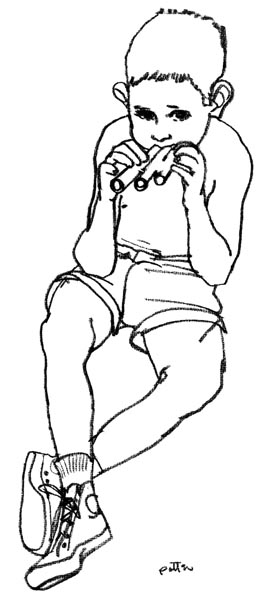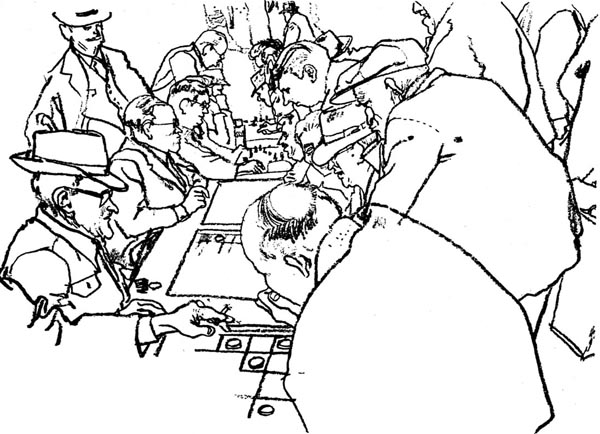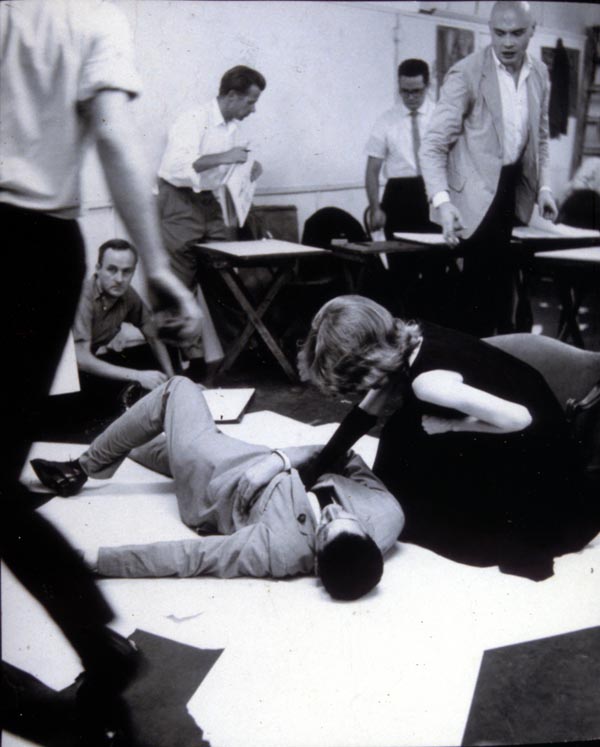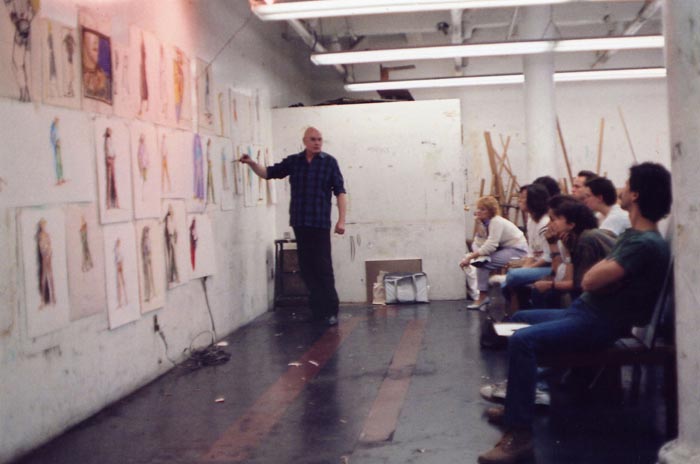When I first stepped foot into Jack Potters class, back in 1997, it was intimidating. Jack, with his bald head and strong voice, had us draw with a “big punchy pencil” on white paper.

The focus was on shape and composition. He wanted us to interpret what we saw rather than draw it as accurately as possible.

There was great energy in the room and much of it had to do with his enthusiasm for his students and the work they were doing.

Jack would find his models at flea markets or anywhere he could during his daily routine. He sought out models that he felt had a certain look that would make our drawings better.

Sometimes he’d have his models pose by themselves but usually he’d put them in some sort of scene. Maybe two models at a table watching television. Or a few models set up to look like a murder scene.

Whatever it was he wanted us to draw the entire composition, get us seeing the shapes and the big picture.
Towards the end of class he’d take one or two drawings, tape them to the wall and give a talk. I remember him telling a student “I want a full meal, not a nibbly snack!” and another time he compared the good in a drawing to MSG in Chinese food.

He was a serious artist but also had a sense of humor. He told us that he became a “caricature” because of his students. He spoke in an exaggerated manner because he felt that he had to be clear when pointing out an idea.

At times he’d also do “diagram” drawings to show us what he felt could be better in our work. The wall talks helped me grasp a visual example of what he was verbally talking about. He gave his all and did his best (in his words) to “push us up the mountain.”
Concluded tomorrow...
* Daniel Zalkus is a freelance illustrator, graduate of the School of Visual Arts and loves to wear plaid. To see samples of his artwork please go to www.zalkus.com
* My Jack Potter Flickr set
We're fortunate if in our 'art' lives we've had an inspiring instructor. I've never been a big fan of Potter's commercial work....I've always felt the drawing a bit weak, good but not exceptional design qualities. But this week's TI has opened my mind and made me aware of his goals and direction and his dedication to creating art as opposed to a reproduction of figures and of scenes. Not well expressed....but his students were benefited greatly by his teaching. Thanks, Daniel, for a fine TI blog.
ReplyDeleteCharlie-
ReplyDeleteI'm happy to share. One of the great things about Today's Inspiration is finding information on artists who, in many ways, have been long forgotten.
I think Jacks true calling was teaching and I say that not to take anything away from his illustration career. During his heyday he was a well known illustrator with big ad campaigns.
One thing I find interesting about his illustration work is that he worked from life as much as possible. As far as I know he never used a project. It was all models and drawing from reference photos (for the backgrounds).
i'm wondering if Potter's brush with the commercial world is what led him to be so irritated and almost allergic to decorative and superfluous surface gloss. his post career agenda was almost exclusively about finding the essence by cutting the fat.
ReplyDeleteTomer-
ReplyDeleteI bet it contributed to it but I think he had those beliefs for years.
His favorite artist, Carl Erickson, was a fashion illustrator who was all about elegance and simplicity of line. He was a big influence on Jack.
The diagram drawings in class, his push for simplicity, and limited "surface gloss" always reminded me of Alex Toth's late work.
Daniel, I assume that by the time a student was taking Jack Potter's class, he or she had solid traditional (accurate) drawing skills. I say that because, as you stated, he focused on shape, composition and the big picture.. but no mention of drawing skills. Carl Erickson, whom you mentioned Potter admired the most, couldn't have drawn those beautiful elegant illustrations without excellent draftsmanship skills. Were good drawing skills a prerequisite for his classes? And, did he ever comment on the work of his competitors, like Peak, Fuchs, English, Briggs, Parker, etc.?
ReplyDeleteFascinating TI week, Daniel.
Tom Watson
Man, I wish I had been in his class. Thank you for posting.
ReplyDeleteWow! Great post! Nicely placed images!I'm so glad you got a photo of him giving one of his famous critiques! They really where my favorite thing about SVA altogether. I LOVE that quote! "I want a full meal, not nibbly bits" HAHAHA, I can hear him saying it in my head.
ReplyDeleteTom-
ReplyDeleteNo prerequisites. Jacks class was a drawing class. Sure he focused on shape, composition and the big picture. That was the point.
Through that you learned, or at least I did, how to better compose images. And to interpret what you saw rather than copy it as accurate as possible.
Jack knew that his teaching wasn't for everyone but wanted his students to at least try it. He felt that it would help. Even if you didn't take his lessons to your own personal work he thought that you might be able to add something new by studying with him.
Jack talked about some of his competitors but not that much. I mentioned in a earlier post this week a bit about Bob Peak.
I remember talking to him about Robert Weaver another artist whom he liked (Weaver also taught at SVA). And Al Parker, someone who he said was an early influence. He used to clip his work but over time it didn't stick with him. The work didn't hold as much interested as it did in his early days as a student/beginning illustrator.
Tom-
ReplyDeleteLet me add...
By interpret that doesn't mean we could go off and draw whatever we wanted. He still wanted us to make drawings that felt like the model (or object).
When I draw I often think of him telling me "Get the proportions!"
So Potter was stressing the overall design of the picture and the drawing the means by which the pattern was assembled.
ReplyDeleteI saw straight away the influence of Al Parker in his work and I see Peak more than Weaver as the next step in that continuum.Thanks for these posts, they've been very enlightening.
One final point, after committing to teaching did Jack move into fine art? Did he carry on painting? I can see why his course was so popular.
Thanks for the reply, Daniel. I taught foundations drawing at the Academy of Art in S.F. from 1995 until 2000, which was a newly formed department. The reason was that ADs were complaining that art schools were not producing students in general, that had good traditional drawing skills for communicating concepts and ideas. By that time, students had to learn quite a broad range of computer skills that dominated their courses and their time, but little drawing skills. Although, illustration majors.. fashion, story and advertising illustration, had to take basic drawing classes.
ReplyDeleteMost art schools prior to the 1970s', gave students a solid academic grounding in drawing and painting, usually the first two or even three years, before taking the innovative, experimental or avant-garde classes. The idea was that once students learned to walk well, they were then able to run.. a building-block process characteristic of traditional learning methods in general.
It's kinda old school thinking on my part, and I'm not criticizing SVA or Potter's approach, but there was definitely a conflict of philosophies that started probably in the late 50s' when I was a student.
It has always made for an interesting discussion over the decades, and what I also find interesting is that in fine arts, the academic ateliers are making a big come-back, because more and more young art students want to learn to paint like the early masters.. before the big modern, abstract and Expressionism push. The thinking being that drawing and painting what we "feel" is instinctive, as it was when we were a child, but painting or drawing correctly what we see, has to be practiced and learned. Virtually all the French Impressionists were very well grounded in literal academic training, but certainly painted with innovation and feeling for their subjects.
Tom Watson
I took Jack Potter's drawing class for 4 years at SVA, then another additional class after I graduated (night class I think). He was the best teacher I ever had. He was such a presence - he wasn't easy & probably scared off a few students I'm sure, but if you wanted to be better at drawing and were willing to learn - his class was the best place to be. No matter what you're level of drawing skills you had, if you were wiling to learn & persevere he would help you become a better artist, not an easy class to be sure, but well worth it. I will never forget him....
ReplyDeleteLorraine Gelard
One of the luckiest days of my life was when I was assigned Jack's class on my first day at VA. Simply the most inspirationally gifted person I have ever met. Love you Jack. (Need a ride home tonight?)
ReplyDelete